From plastics invading the Arctic Ocean to the changing morphology of birds in response to rising temperatures and the problems with pathogens killing off pollinators like bees, we examine some of the effects of climate change on Earth’s ecosystems. Plus, Ganymede, moonlight, solar cells, and this week in rocket history, we look back at STS-83.
Podcast
Show Notes
Ganymede’s auroral footprint on Jupiter traced
- SwRI press release
- “A Comprehensive Set of Juno In Situ and Remote Sensing Observations of the Ganymede Auroral Footprint,” V. Hue et al., 2022 February 16
- VIDEO: SwRI scientists connect the dots between Galilean moon, auroral emissions on Jupiter (YouTube)
Using moonlight to calibrate telescopes
- NASA press release
New photoelectric cells turn waste heat into energy
- Solar cell keeps working long after sun sets (EurekAlert)
- “Nighttime electric power generation at a density of 50 mW/m2 via radiative cooling of a photovoltaic cell,” Sid Assawaworrarit, Zunaid Omair, and Shanhui Fan, 2022 April 5, Applied Physics Letters
Plastic flood
- AWI press release
- “Plastic pollution in the Arctic,” Melanie Bergmann et al., 2022 April 5, Nature Reviews Earth & Environment
Bird shapes impacted by climate change
- Recent changes in bird morphology – probably due to global warming (EurekAlert)
- “Widespread recent changes in morphology of Old World birds, global warming the immediate suspect,” Shahar Dubiner and Shai Meiri, 2022 February 17, Global Ecology and Biogeography
Sunflowers help “insect apocalypse”
- University of Massachusetts Amherst press release
Coffee improved by insects and birds
- The University of Vermont press release
- “Interacting pest control and pollination services in coffee systems,” Alejandra Martínez-Salinas et al., 2022 April 4, PNAS
This Week in Rocket History: STS-83
- STS-83 Space Shuttle Mission Report (NASA via Scribd)
- STS-83 mission page (NASA)
Transcript
It’s a grim news day today as we look at several stories about climate change and the impact on birds, bees, and the Arctic.
But there is good news when it comes to coffee, which is how this show runs, so there’s that.
And we’ll look at how Ganymede makes aurorae at Jupiter.
How moonlight is being used to improve the accuracy of telescopes.
And possibly how some new solar cells can take in waste heat.
Oh, and they let me look back at another space shuttle mission this week!
All of this now, right here on the Daily Space.
I am your host Dr. Pamela Gay.
I am your host Erik Madaus.
And we’re here to put science in your brain.
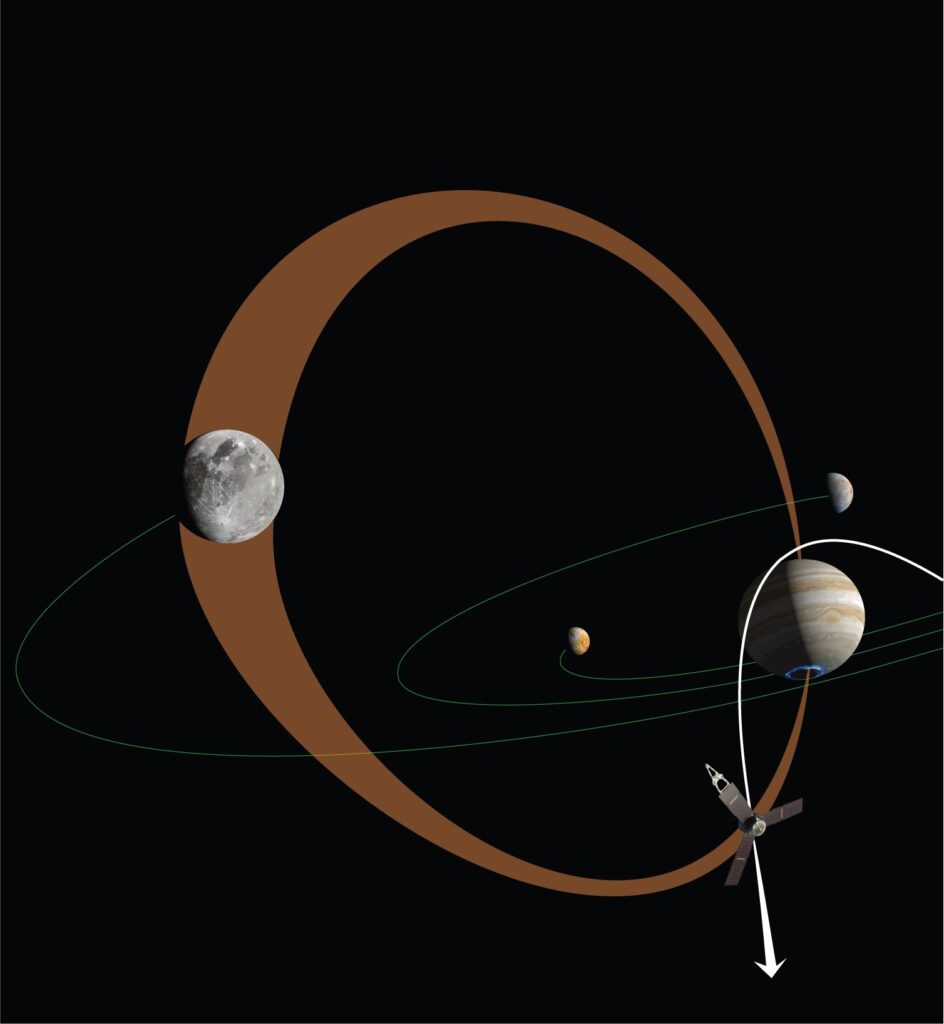
Today’s news starts at Jupiter, with news from the Juno spacecraft team about its November 8, 2020 passage through the magnetic field connecting Jupiter and Ganymede. According to Thomas Greathouse, the mission used its JADE and UVS instruments during this passage, and “JADE measured the electrons traveling along the magnetic field lines, while UVS imaged the related auroral footprint spot.” These measurements allowed the team to see how this massive moon and planet were connected and affecting one another.
This work is published in Geophysical Research Letters with lead author Vincent Hue, who explains: Jupiter’s most massive moons each create their own auroras on Jupiter’s north and south poles. Each auroral footprint, as we call them, is magnetically connected to [its] respective moon, kind of like a magnetic leash connected to the moon glowing on Jupiter itself.
Jupiter’s aurorae glow in colors our eyes can’t see: X-ray and ultraviolet light. These effects and many other details of Jupiter will be studied in detail by the upcoming JUICE mission. For now, it is mathematically daunting and scientifically awesome to understand that the complex aurorae are formed by the ever-changing motions of Jupiter’s moons within the ever-fluctuating solar wind.
To understand the planets in our solar system, we have to study them in the context of their moons. This is as true of our planet Earth as it is of Jupiter. One problem Earth has to deal with that so far we haven’t had at Jupiter is the need to calibrate multiple, simultaneous missions to make sure they are all measuring things the same. NASA alone has over twenty spacecraft studying our world, and researchers are turning to the Moon for calibration.
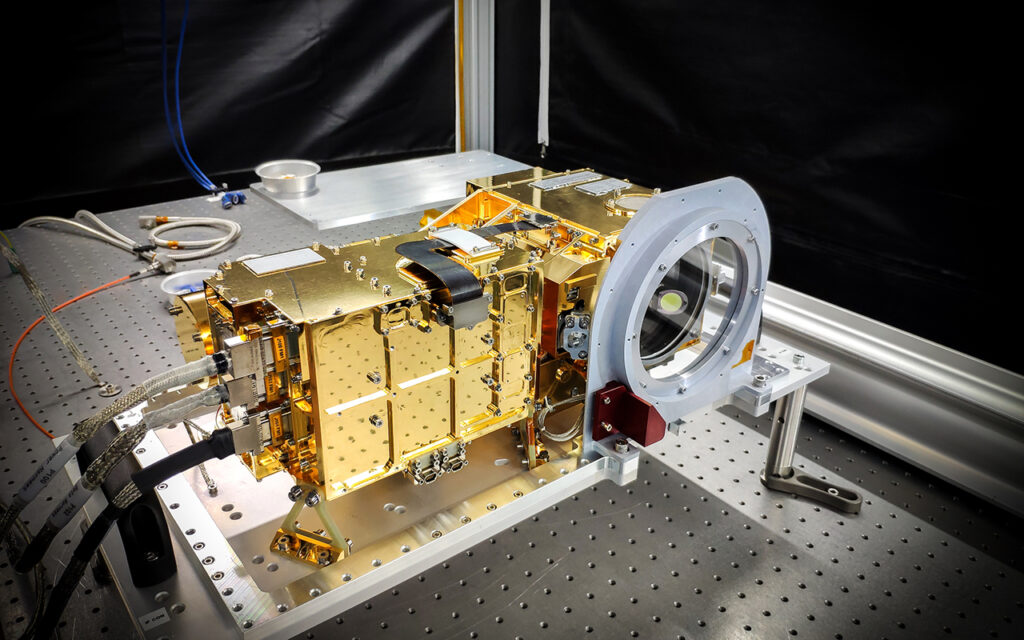
In a NASA update on the air-LUSI telescope, Principal Investigator Kevin Turpie said: Having a common calibration source outside of the Earth will help us reach this objective. Once air-LUSI measurements are used to improve the accuracy of the total amount of light coming from the Moon, we can take extensively more accurate measurements of Earth using current and future space-borne observatories.
Air-LUSI most recently flew on March 12 to16 onboard NASA’s ER-2 aircraft, a civilian modified U2 spy plane that can fly at an altitude of 21 kilometers, which places it above 95% of the atmosphere. It measured the Moon’s brightness near full.
Turpie further explains: The Moon is extremely stable and not influenced by factors on Earth-like climate to any large degree. It becomes a very good calibration reference, an independent benchmark, by which we can set our instruments and see what’s happening with our planet.
The Moon’s brightness also isn’t affected by artificial light or other more human factors, at least not yet. For now, this nearby world will be our standard candle for measuring planet Earth.
Global pictures of our planet at night are one of the greatest indicators not just of population distributions but also of infrastructure distributions. There are myriad places – even here in the U.S. – where people live in remote locations that aren’t wired into the power grid. For these folks, life doesn’t have to be low tech, but sometimes it does end up being rather diurnal.
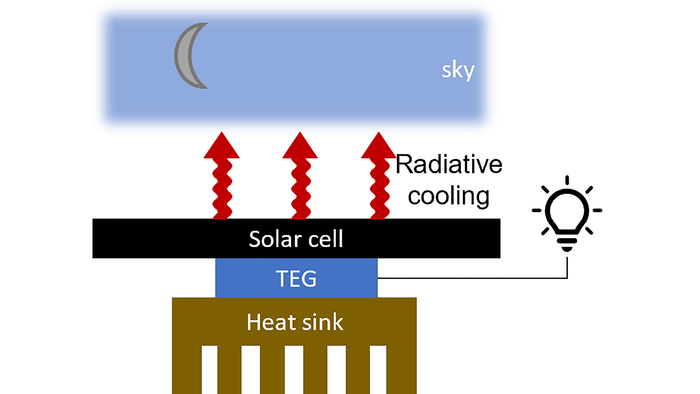
Solar panels have become a reliable and more or less affordable way for anyone to get power, at least while the Sun is up. Unfortunately, batteries and all the associated hardware that are needed to store electricity are still costly, bulky, and less affordable. This means that for some, with the setting Sun, everything powers down until morning.
Part of this problem can be mitigated if other means of energy generation can be found, and the solar panels themselves may just be one possible alternative source.
During daylight, solar panels heat up as they are only able to transform some of the solar energy into power. A perfectly effective solar panel would be at the same temperature as the surrounding air. During the night, that heat energy radiates away and is lost in the surrounding air. In a new paper in Applied Physics Letters, researchers describe a new photoelectric cell that harvests heat energy, both from the solar panels and the surrounding air. This can generate around-the-clock power and turn what would otherwise be waste heat into new energy. This work was led by Sid Assawaworrarit.
According to project researcher Zunaid Omair: What we managed to do here is build the whole thing from off-the-shelf components, have a very good thermal contact, and the most expensive thing in the whole setup was the thermoelectric itself.
Fellow researcher Shanhui Fan adds: None of these components were specifically engineered for this purpose. So, I think there’s room for improvement, in the sense that, if one really engineered each of these components for our purpose, I think the performance could be better.
Here is to hoping that this tech can be commercialized in the not too distant future, and we can start to power the world around the clock without needing more batteries.
We’re changing our world. That can no longer be denied. But we may be able to tech our way into changing it less as we move forward.
Up next, we look at the sometimes creative ways Nature is finding to overcome the changes humans are making.
We can’t seem to go a week without talking about the impact of climate change on our planet, and this week is no different.

First up, plastic. It’s everywhere. Literally now. The flood of large bits of plastic, as well as tiny, horrible microplastics, has finally reached the Arctic. In fact, according to new research from the Alfred Wegener Institute, high concentrations of those microplastics have now been found in the water, on the seafloor, and even in the ice and snow. The team’s study was published in Nature Reviews Earth & Environment.
This paragraph from their press release speaks volumes: Today, between 19 and 23 million metric tons of plastic litter per year end up in the waters of the world – that’s two truckloads per minute. Since plastic is also very stable, it accumulates in the oceans, where it gradually breaks down into ever smaller pieces – from macro- to micro- and nanoplastic and can even enter the human bloodstream. And the flood of debris is bound to get worse: global plastic production is expected to double by 2045.
To get to the Arctic, plastics are carried on the ocean currents from the Atlantic and the North Sea and from the Pacific over the Bering Strait. Some of the tiniest particles are actually carried to the region by the wind. There are numerous rivers that empty into the Arctic, and they bring their own plastic with them from places like Siberia. Plus, all those microplastics get frozen into the ice during seasonal changes, and some of that ice travels as ice floes that then melt when they reach the warmer regions around Greenland and Svalbard in the summer.
All this plastic is simply terrible for the ecosystem, particularly the animals. Everything from plankton to sperm whales has been found to come in contact with and sometimes ingest plastic, and for the Arctic species, the effects are no different. As lead author Melanie Bergmann explains: …there is evidence that the consequences there are similar to those in better-studied regions: in the Arctic, too, many animals – polar bears, seals, reindeer, and seabirds – become entangled in plastic and die. In the Arctic, too, unintentionally ingested microplastic likely leads to reduced growth and reproduction, to physiological stress and inflammations in the tissues of marine animals, and even runs in the blood of humans.
Additionally, all those trapped microplastic particles are changing the albedo of the ice and snow, making it darker, absorbing sunlight more rapidly, and causing a higher melt rate. If they get into the atmosphere, they cause clouds and rain, as we discussed a little last week when talking about solid aerosols.
At the end of the day, Bergmann notes: …the Arctic is warming three times faster than the rest of the world.”
That’s not painting a pretty picture, so let’s look at some birds instead.

Researchers in Israel recently published the results of a study of eight thousand birds. They’ve noticed changes in the bird’s shape or morphology that they claim are because of climate change.
According to a standard rule of body shape, animals living in warm climates are smaller than those of the same species in a colder climate because the larger volume to surface area ratio is better in warmer climates. The hypothesis from this is that animals will become smaller, except those that live near humans.
The researchers studied 106 different species of birds in Israel including wild birds, migratory birds, and birds that have adapted to live near humans. The end result was evidence of a morphological shift – birds had become lighter or bigger but crucially not both. The results were found in birds that came to Israel from around the world, meaning that the shift is not just a local phenomenon but impacts the entire world. According to the researchers: We think that these are two different strategies for coping with the same problem, namely the rising temperatures. In both cases, the surface area to volume ratio is increased… which helps the body lose heat to its environment.
Both changes were noticed in all three categories of birds, though migratory birds generally had the body mass reduction characteristic and non-migratory birds became longer. Contrary to predictions, the human-accustomed birds also had these changes instead of getting bigger as the researchers expected.
These changes were noticed in only a seventy-year period, which means that climate change is impacting birds rapidly. The researchers caution that this does not represent an evolutionary change but flexibility in the phenotype or physical presentation of genes. The researchers do not know if the birds have enough ability to cope with temperatures continuing to rise.
This work was published in the journal Global Ecology and Biogeography with first author Shai Meiri.
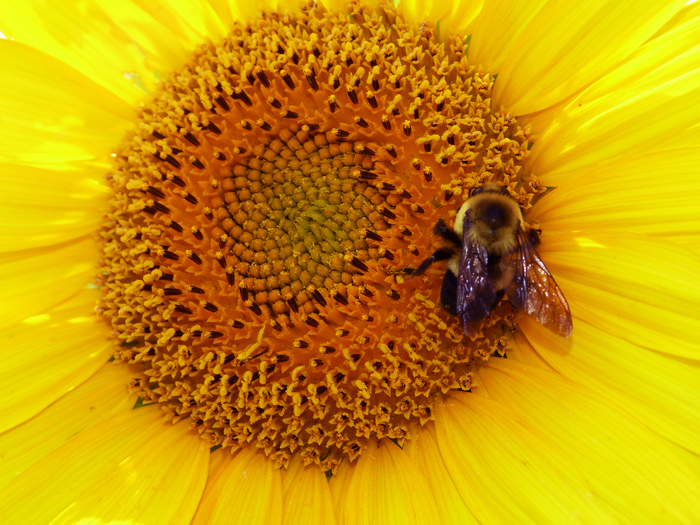
Another major concern of climate change is insects that we rely on to grow food getting infected by pathogens that seem to be thriving while the insect populations are becoming more fragile. One species particularly impacted by this is bees, which have been facing waves of die-offs due to pathogens for the last decade. New research from the University of Massachusetts plans to figure out how this happens by focusing on the food provided to bees, and they have received a $2.4 million grant from the NSF to do so.
Plant pollinators like bees provide an estimated $200 billion worth of services around the globe if you consider just how much they do to keep our food supplies growing. But the same plants that are being pollinated are also hosting the diseases that kill off those same pollinators, and scientists have not really examined just what that means for the pollinator population. According to lead researcher Lynn Adler: Our ultimate goal with this grant is to figure out what sort of plant composition, available as food sources for the pollinators, reduces infection?
One potential source of a so-called superfood for bees is… sunflowers.
Adler’s new research team consists of scientists from a wide range of disciplines, including ecologists, mathematical modelers, biochemists, and molecular biologists, all of whom will work together to paint an incredibly detailed and comprehensive picture of the relationship between our food supply, pollinating insects, and pathogens. Additionally, the team will be launching a graduate training program and an after-school program to help the next generations of scientists understand this deeply interconnected and important system.
We look forward to hearing about their results as their research progresses.
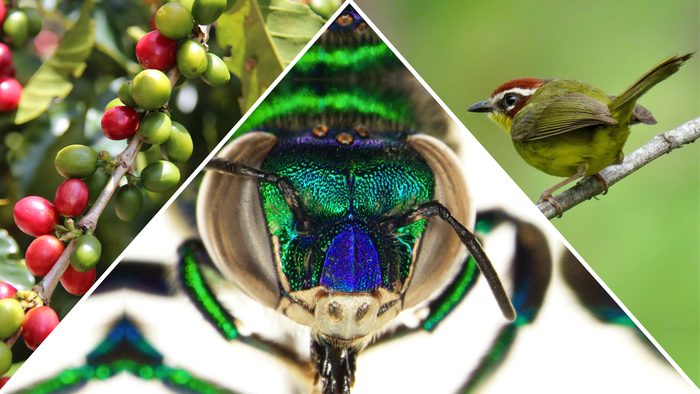
The theme of this segment so far has been the impacts of climate change on the food supply, and this story isn’t different, but there is a tiny bit of good news. Plus cute animals. Coffee is basically the reason this show gets done every day, so we’re bringing you this story.
Coffee is a fickle plant, requiring a narrow range of growing conditions, which are changing because of climate change. This is making coffee more expensive.
The leading coffee plant, arabica, is self-pollinating, but there is a significant benefit to other animals helping. Birds eat pests that damage the beans, and bees provide more pollination help. Fortunately, insects and birds do this for free, even traveling thousands of miles to do so as new research in the Proceedings of the National Academy of Sciences shows. The purpose of the study was to quantify the benefit of the pollination of both species together, as previous studies considered them separately. According to first author Alejandra Martínez-Salinas: …nature is an interacting system, full of important synergies and trade-offs. We show the ecological and economic importance of these interactions, in one of the first experiments at realistic scales on actual farms.
Turns out the difference is quite significant and well more than the separate benefits added together. The coffee plants helped by insects and birds had bigger fruit weight and uniformity. The researchers calculated that each field would see a 25% drop in yield without the combination of pollinators. This works out to over $1,000 per hectare less profit for the farmer.
The research study involved first excluding bees, then birds, then both and finally letting both at the plants. The work was done at thirty farms across Latin America and the U.S.
Tying this back to climate change, the researchers caution that the habitat that these beneficial animals live in is being impacted by climate change and human activity. Natalia Aristizábal, a Ph.D. student at the University of Vermont involved in the study, said: One important reason we measure these contributions is to help protect and conserve the many species that we depend on, and sometimes take for granted.
And now, it’s time for our weekly rocket history segment.
This Week in Rocket History
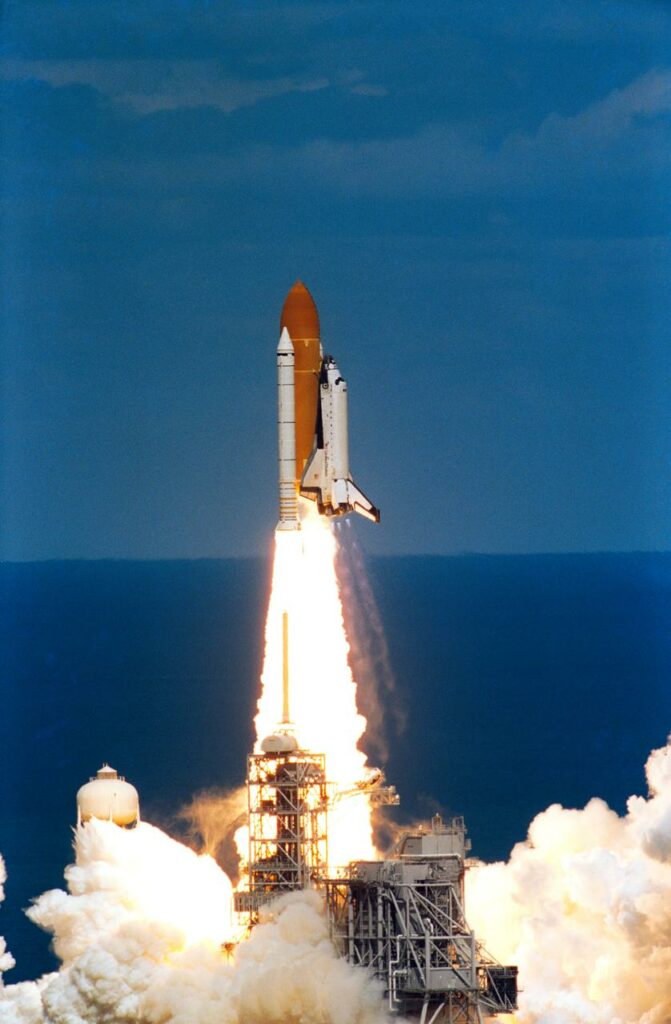
STS-83 launched on April 4, 1997, in the afternoon local time. It was originally scheduled to launch the previous day, but that attempt was scrubbed because of fuel cell problems, and they were determined to be in the normal range and cleared for flight. The fuel cells used liquid oxygen and liquid hydrogen to produce electrical power and drinking water for the crew. The significance of this will become apparent shortly.
As far as Space Shuttle missions, STS-83 was fairly unique. It had two female astronauts in its seven-member crew, Payload Commander Janice Voss and Pilot Susan Still, which hadn’t happened all that often even in 1997. Columbia would become the first American spacecraft to be commanded by a woman, Eileen Collins, who flew STS-93 in 1999. It was also unique because of its mission length. The average shuttle mission was at least a week, missions using Columbia or Endeavour tended to be longer because of their unique Extended Duration Orbiter capabilities.
STS-83 was planned for fifteen days in space. However, Columbia returned to Kennedy just under four days after launch, one of only three missions ever to do so. The other two early returns were because of problems with the fuel cells. However, the mission payload was so important that NASA left all of the equipment in Columbia and reflew the mission later in the year as STS-94. No, there weren’t eleven flights between the two missions – the shuttle missions were planned out years in advance, so the mission numbers were not always in chronological order.
STS-83 reached orbit without any problems, but shortly thereafter fuel cell number two started to have voltage issues. According to NASA: There are three fuel cells on each orbiter, each containing three substacks made up of two banks of 16 cells.
For safety reasons any fuel cell which had an increase in voltage above a certain level had to be shut down, else it could have pulled even more voltage to it from the other cells and caused a fire. Shutting down one of the fuel cells triggered one of the flight rules that required all three fuel cells to be functioning for landing. This was because they provided electrical power for the Orbiter’s flight surfaces and engines. Fuel Cell 2 continued to have problems and was shut down for the rest of the mission on April 6, 1997, setting Columbia up for an early return.
The loss of one-third of its electrical power and more than three-quarters of its mission duration, however, didn’t mean that nothing was accomplished on Columbia during the abbreviated mission. Only one of the two experiments on the EXPRESS rack was done, but other experiments were completed successfully. These were contained in four other areas: two furnaces, a combustion box, and a glovebox.
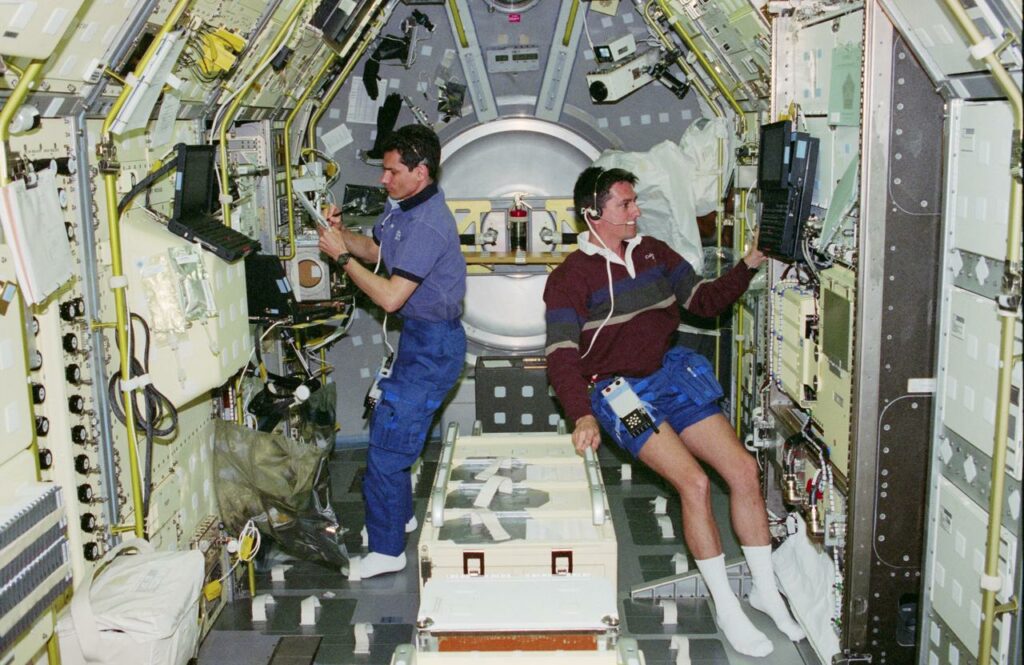
The furnace experiments included an experiment aimed at determining how far molten metals could be cooled before they solidified and another where solid metal was mixed with the molten metal of a different type to determine how the two bonded, without the whole combination melting again. Other experiments, in the glovebox, included three protein crystal experiments and a plant experiment. The plant experiments even used a computer running Debian Linux, which was brand new in 1997.
STS-83 landed back at the Kennedy Space Center on April 8, 1997, after just three days, 23 hours, and thirteen minutes in space. As I mentioned, the entire mission was reflown as STS-94. It would become the first time more than two of the same crew flew into space together a second time, as all seven crew members from STS-83 also flew on STS-94.
So what was so important that Shuttle program managers left everything in the orbiter and flew the same mission with the same crew just three months later? The Microgravity Science Laboratory.
The Microgravity Science Laboratory was one of the first missions to prove the technology for the International Space Station (ISS), the first module of which would be launched in the following year. Installed in the Spacelab double module was the new EXPRESS rack, which would be used to host experiments on the International Space Station. It was even fitted to the Spacelab in the same way that it would be fitted to the ISS. Two of the nineteen experiments on STS-83 were installed in this rack, with the others in the remaining space of the module and in the shuttle proper. As usual, the astronauts carried the SAREX radio, as three crew members were amateur radio operators.
The astronauts also conducted experiments on flames, particularly how balls of flame form in microgravity and how they stick around, but not all of the planned data was taken because of the fuel cell problem.
Statistics
And now, for some statistics.
The number of toilets in space is eight: four on the ISS, one on the Soyuz, one on the Crew Dragon, one on Shenzhou 13, and one on Tianhe.
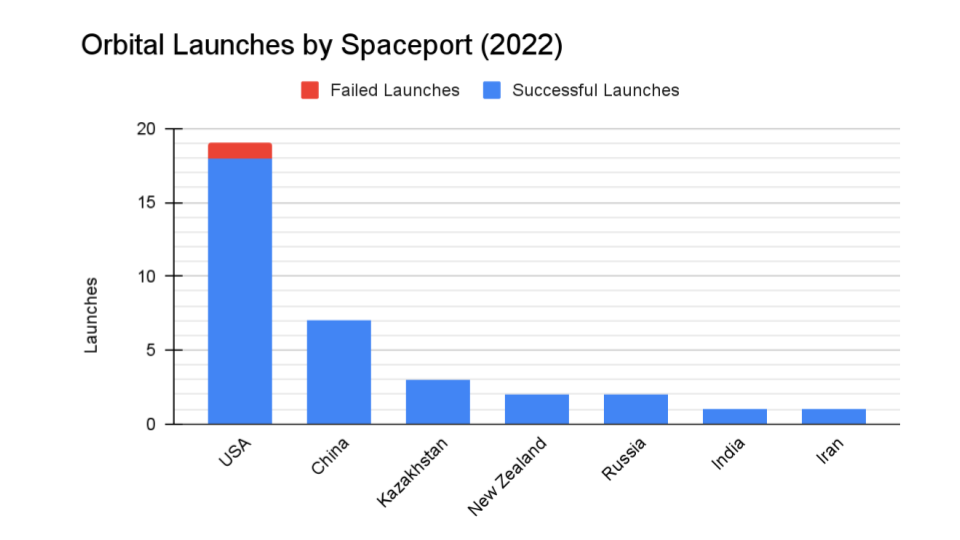
We keep track of orbital launches by launch site, also called spaceport. Here’s that breakdown:
USA 19
China 7
Kazakhstan 3
New Zealand 2
Russia 2
India 1
Iran 1
From those 35 launches, a total of 634 spacecraft were put into orbit.
Your random space fact for this week is that, after sending up fifteen fruit flies and getting back over 3,000 with immune system issues in 2006, NASA proposed a Fruit Fly Lab for the International Space Station, which was sent up in December 2014 aboard a SpaceX Dragon.
This has been the Daily Space.
You can find more information on all our stories, including images, at DailySpace.org. As always, we’re here thanks to the donations of people like you. If you like our content, please consider joining our Patreon at Patreon.com/CosmoQuestX.
Credits
Written by Pamela Gay, Beth Johnson, Erik Madaus, and Gordon Dewis
Hosted by Pamela Gay, Beth Johnson, and Erik Madaus
Audio and Video Editing by Ally Pelphrey
Content Editing by Beth Johnson
Intro and Outro music by Kevin MacLeod, https://incompetech.com/music/


 We record most shows live, on Twitch. Follow us today to get alerts when we go live.
We record most shows live, on Twitch. Follow us today to get alerts when we go live.